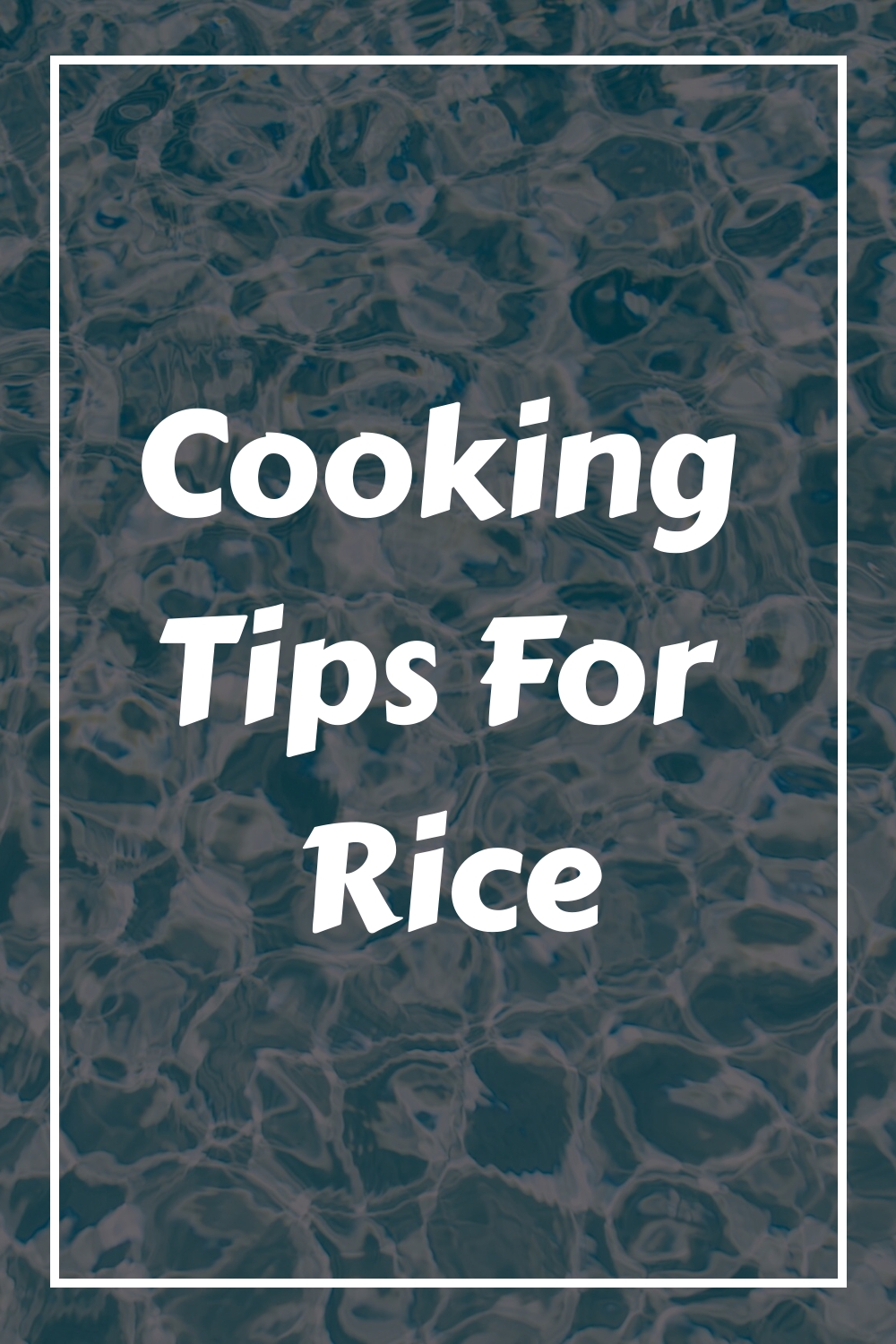
If you’re looking to improve your rice-cooking skills, this article is just for you. Packed with valuable cooking tips, it will help you achieve perfectly fluffy and delicious rice every single time. From choosing the right type of rice to mastering the perfect water-to-rice ratio, these tips will elevate your culinary game and make your rice dishes truly shine. So, grab a pen and paper, and get ready to take your rice-cooking skills to the next level!
Choosing the right type of rice
When it comes to choosing the right type of rice, there are several factors to consider. First and foremost, you should think about the cooking method you plan to use. Different types of rice have varying cooking times and absorbencies, so it’s essential to choose a type that aligns with your chosen cooking method.
Another crucial consideration is the desired texture of the rice. Some people prefer their rice to be light and fluffy, while others enjoy a stickier, more compact texture. The type of rice you choose can significantly impact the final texture, so it’s essential to be mindful of this when making your selection.
In addition to cooking method and texture, it’s helpful to take note of the cultural cuisine you’re preparing. Different cuisines often call for specific types of rice, as they can contribute to the overall flavor and authenticity of a dish. For example, Japanese cuisine commonly utilizes short-grain rice, while Indian cuisine often features aromatic Basmati rice.
Lastly, considering the nutritional value of the rice is important, especially if you’re looking to make a health-conscious choice. Some types of rice, such as brown rice, offer more fiber and nutrients compared to others. Understanding your dietary needs and preferences can help guide you in selecting a rice variety that aligns with these factors.
Preparing the rice
Before even starting the cooking process, proper preparation is essential for achieving perfect rice. There are a few essential steps to take to ensure your rice turns out just right.
The first step is rinsing the rice. Rinsing helps remove any excess starch from the grains, which can lead to gummy rice. Place the rice in a fine-mesh strainer and rinse it under cold water until the water runs clear. This simple step will help prevent any unwanted stickiness in your cooked rice.
Another important step in rice preparation is soaking the rice. Soaking can help improve the texture and ensure even cooking. Depending on the type of rice, soaking times may vary, but generally, 30 minutes to an hour should suffice. Soaking also helps reduce the cooking time, making it a valuable step for busy cooks.
Once the rice is rinsed and soaked, it’s crucial to measure the water and rice ratio correctly. The proper ratio is typically one part rice to two parts water, but this can vary depending on the type of rice and desired texture. Following the recommended ratio will help you achieve fluffy, perfectly cooked rice.
If you’d like to add extra flavor to your rice, this is the time to do it. Adding flavorings or seasonings such as herbs, spices, or even broth can elevate the taste of your rice. Just remember to adjust the water ratio accordingly to account for any additional liquids you add.

Cooking methods for rice
There are numerous cooking methods available for preparing rice, each with its advantages and considerations. Let’s explore some popular methods to help you find the one that suits your needs best.
The stovetop method is the traditional way of cooking rice. It involves boiling rice in water and then simmering it until all the liquid is absorbed. This method requires monitoring the rice closely to prevent it from burning or overcooking.
Rice cookers provide a convenient and foolproof way to cook rice. Simply add the rinsed and soaked rice and the appropriate amount of water, close the lid, and let the cooker do its magic. Rice cookers often come with additional features such as settings for different rice types and a keep-warm function.
The microwave method offers a quick and easy way to cook rice, especially for smaller portions. Simply place the rinsed rice and water in a microwave-safe dish, cover it loosely, and microwave on high until the water is absorbed. This method is ideal for those short on time or lacking stovetop or rice cooker access.
For those who prefer an unconventional method, the oven method can be a great option. It involves baking the rice in the oven, resulting in evenly cooked grains. This method allows for more precise control of the cooking process and is particularly useful when preparing large quantities of rice.
Another popular cooking method is the Instant Pot method. The Instant Pot is a multi-cooker that combines several cooking functions in one device, including pressure cooking. Cooking rice in an Instant Pot yields consistent results in a shorter time compared to traditional stovetop methods.
Adding flavor to rice
While rice on its own can be delicious, adding flavorings or seasonings can take it to the next level. Here are a few ways to infuse your rice with additional taste.
One simple way to enhance the flavor of your rice is by using broth instead of water. Whether it’s vegetable, chicken, or beef broth, swapping water for broth adds a savory element to your rice. This method is particularly useful when serving rice as a side dish or as a base for stews and curries.
Herbs and spices are another excellent way to add depth and complexity to your rice. Consider adding aromatics like garlic, onion, or ginger to the cooking process to infuse the rice with subtle flavors. Additionally, incorporating spices like turmeric, cumin, or saffron can lend a vibrant hue and distinct taste to your rice.
If you’re looking to incorporate more vegetables into your meals, mixing them into your rice is a fantastic option. Vegetables like peas, carrots, corn, or bell peppers can add color, texture, and nutritional value to your rice dish. Simply sauté or blanch the vegetables before mixing them in with the cooked rice.
For a fusion twist, you can mix in sauces or condiments to flavor your rice. Soy sauce, oyster sauce, or even hot sauce can give your rice a savory, tangy kick. Whether you’re aiming for an Asian-inspired stir-fry or a Mexican-inspired rice bowl, these additions can enhance the overall taste of your dish.

Ensuring proper rice texture
Achieving the right texture in cooked rice is key to a satisfying meal. Here are some tips to help you ensure your rice turns out perfectly every time.
Adjusting the water ratio is crucial for achieving the desired texture in your rice. More water will result in a softer, stickier rice, while less water will yield a drier, fluffier texture. Experiment with the ratios to find your ideal balance and adjust it based on the type of rice you’re using.
Apart from water ratio, the cooking temperature also plays a significant role in rice texture. Too high of a heat can lead to uneven cooking or scorching, while too low of a heat may leave you with undercooked rice. Finding the right balance is essential for perfectly cooked grains.
Allowing the rice to rest before serving is an often overlooked but important step. Once the rice is cooked, remove it from the heat source and let it sit, covered, for a few minutes. This resting period allows the residual heat to distribute evenly throughout the rice, resulting in a more uniform texture and flavor.
Avoiding common mistakes
Even the most seasoned cooks can make mistakes when it comes to cooking rice. Here are some common pitfalls to be aware of and avoid.
Using too much water is a mistake that can lead to overcooked and mushy rice. It’s essential to measure the water accurately and follow the recommended ratio to avoid this common error.
Lifting the lid and checking on the rice while it’s cooking can disrupt the cooking process and result in unevenly cooked grains. The steam trapped inside the pot is crucial for even cooking, so resist the temptation to peek until the allotted cooking time is up.
Stirring the rice too often can cause it to become sticky and clumpy. While a gentle stir at the beginning can help distribute the water and prevent sticking, excessive stirring can break the grains and affect the overall texture.
Cooking rice at too high of a temperature can lead to burnt or scorched rice at the bottom of the pot. It’s important to adjust the heat to a gentle simmer once the water starts boiling to avoid this mishap.

Storing and reheating rice
If you find yourself with leftover rice, proper storage and reheating methods can help you enjoy it again without sacrificing quality.
Properly storing cooked rice is essential to prevent bacterial growth and maintain its freshness. Allow the cooked rice to cool to room temperature before transferring it to an airtight container and refrigerating it. Consume the stored rice within a few days to ensure its quality.
When reheating rice, it’s important to add some moisture back to prevent it from becoming dry. You can do this by sprinkling a few drops of water over the rice before reheating it in the microwave or on the stovetop. Covering the dish with a damp paper towel or microwave-safe lid can also help retain moisture.
To avoid ending up with mushy reheated rice, it’s best to reheat it gently and for a short duration. Stirring the rice occasionally during the reheating process can also help distribute the heat evenly and prevent any pockets of overcooked or undercooked grains.
Using leftover rice
Leftover rice doesn’t have to go to waste. In fact, it can be transformed into delicious dishes that are quick and easy to make. Here are a few ideas for using leftover rice.
Making fried rice is a classic way to repurpose leftover rice. Heat some oil in a pan, add chopped vegetables or protein of your choice, and stir in the cooked rice. Season with soy sauce, garlic, and any other desired flavors, and you’ll have a flavorful and satisfying meal in no time.
Another option is to create rice salads. Toss the cold leftover rice with a variety of fresh vegetables, proteins like chicken or shrimp, and a light dressing. This refreshing and nutritious dish is perfect for hot summer days or as a picnic or potluck contribution.
Leftover rice can also be used in soups or stews to add bulk and texture. Whether it’s a hearty chicken and rice soup or a comforting rice and lentil stew, the addition of cooked rice can turn a simple dish into a filling and satisfying meal.
For those with a sweet tooth, leftover rice can even be used to prepare rice-based desserts. Rice pudding, for example, is a creamy and comforting treat that can be enjoyed warm or chilled. By adding milk, sugar, and flavors like vanilla or cinnamon to the cooked rice, you’ll have a delightful dessert in no time.
Understanding different types of rice
Rice comes in various shapes, sizes, and flavors, offering a wide range of culinary possibilities. Understanding the characteristics of different types of rice can help you make informed choices when selecting the right variety for your dishes.
Long-grain rice, as the name suggests, has long and slender grains that remain separate and fluffy when cooked. This type of rice is ideal for pilafs, stir-fries, and side dishes. Basmati rice, a type of long-grain rice, is known for its fragrant aroma and is a staple in Indian and Middle Eastern cuisine.
Medium-grain rice has grains that are shorter and plumper compared to long-grain rice. When cooked, this rice tends to be moist and tender, making it a popular choice for dishes like risotto and paella.
Short-grain rice is sticky and clumps together when cooked, making it ideal for dishes like sushi or rice puddings. The stickiness of short-grain rice makes it easy to shape into balls or rolls, which is crucial for sushi preparation.
Basmati rice, as mentioned earlier, is a long-grain rice variety known for its distinct aroma and flavor. It has a nutty and floral fragrance and pairs well with various curries and spicy dishes. Basmati rice is commonly used in Indian, Pakistani, and Middle Eastern cuisines.
Jasmine rice is another aromatic rice variety that is popular in Southeast Asian cuisine, particularly Thai cuisine. It has a fragrant and slightly sweet aroma, and the cooked grains are soft and cling together, making it a versatile choice for both savory and sweet dishes.
Arborio rice, often associated with Italian cuisine, is a short-grain rice variety used primarily in risotto. It has a high starch content, giving risottos a creamy and velvety texture. The grains are plump and absorb a significant amount of liquid during cooking.
Alternative rice cooking methods
While the stovetop method and rice cookers are the most commonly used cooking methods, there are some alternative techniques to explore for those who enjoy experimenting in the kitchen.
Baking rice in parchment paper provides a unique and flavorful way to cook rice. By sealing the rice, water, and desired seasonings in parchment paper and baking it in the oven, you can achieve a more intense flavor profile and keep the rice moist throughout the cooking process.
Steaming rice is another method that can yield excellent results, particularly for sushi rice or Chinese sticky rice. Using a steamer basket or a bamboo steamer, place the rinsed rice in a heatproof container and steam it until cooked. Steaming helps retain the natural flavors and textures of the rice.
For those who prefer a more unconventional approach, using a rice sock can be an interesting option. A rice sock is essentially a cloth bag filled with rice that is heated in the microwave and used to cook the rice. This method provides a fuss-free way to prepare small portions of rice without the need for a stove or additional cookware.
With all these different cooking methods and techniques, the possibilities for enjoying rice are endless. Whether you’re a seasoned cook or a novice in the kitchen, experimenting with various types of rice, flavors, and cooking methods can result in delightful meals that are sure to please everyone at your table. So go ahead and explore the world of rice – your taste buds will thank you!
Generated with Pin Generator


